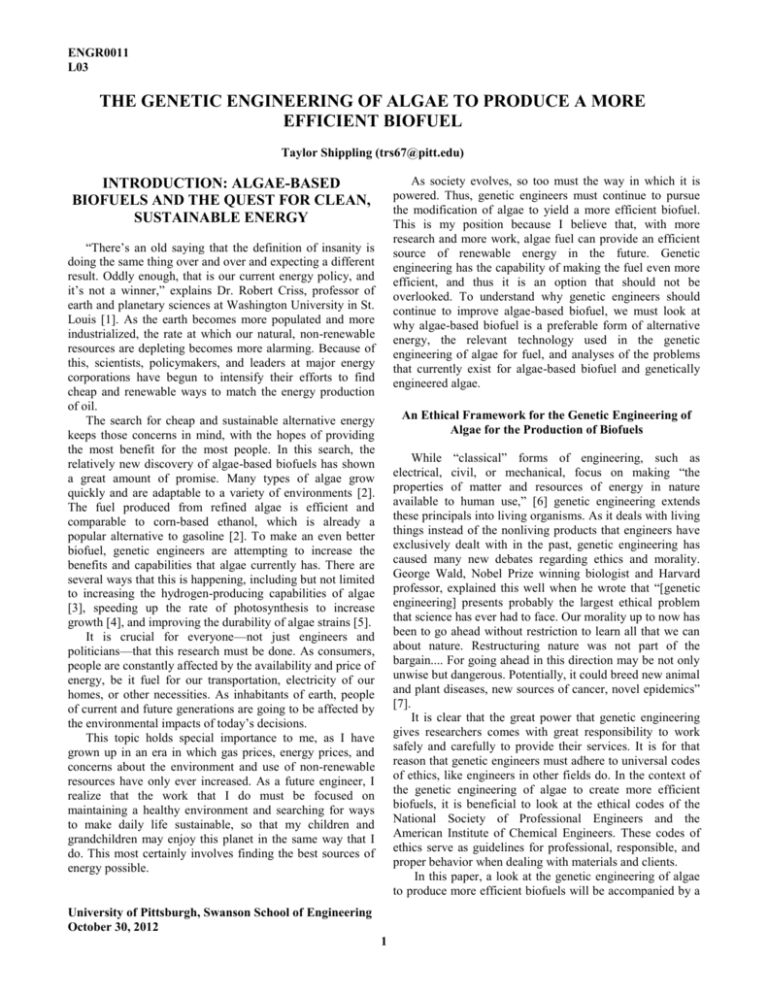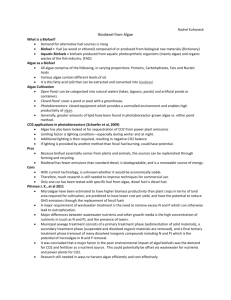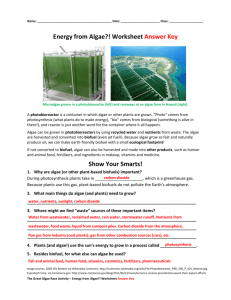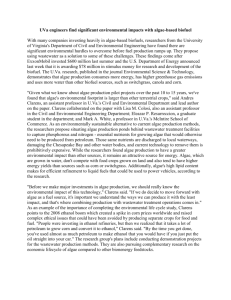The Genetic Engineering of Algae to Produce a More Efficient Biofuel
advertisement

ENGR0011 L03 THE GENETIC ENGINEERING OF ALGAE TO PRODUCE A MORE EFFICIENT BIOFUEL Taylor Shippling (trs67@pitt.edu) As society evolves, so too must the way in which it is powered. Thus, genetic engineers must continue to pursue the modification of algae to yield a more efficient biofuel. This is my position because I believe that, with more research and more work, algae fuel can provide an efficient source of renewable energy in the future. Genetic engineering has the capability of making the fuel even more efficient, and thus it is an option that should not be overlooked. To understand why genetic engineers should continue to improve algae-based biofuel, we must look at why algae-based biofuel is a preferable form of alternative energy, the relevant technology used in the genetic engineering of algae for fuel, and analyses of the problems that currently exist for algae-based biofuel and genetically engineered algae. INTRODUCTION: ALGAE-BASED BIOFUELS AND THE QUEST FOR CLEAN, SUSTAINABLE ENERGY “There’s an old saying that the definition of insanity is doing the same thing over and over and expecting a different result. Oddly enough, that is our current energy policy, and it’s not a winner,” explains Dr. Robert Criss, professor of earth and planetary sciences at Washington University in St. Louis [1]. As the earth becomes more populated and more industrialized, the rate at which our natural, non-renewable resources are depleting becomes more alarming. Because of this, scientists, policymakers, and leaders at major energy corporations have begun to intensify their efforts to find cheap and renewable ways to match the energy production of oil. The search for cheap and sustainable alternative energy keeps those concerns in mind, with the hopes of providing the most benefit for the most people. In this search, the relatively new discovery of algae-based biofuels has shown a great amount of promise. Many types of algae grow quickly and are adaptable to a variety of environments [2]. The fuel produced from refined algae is efficient and comparable to corn-based ethanol, which is already a popular alternative to gasoline [2]. To make an even better biofuel, genetic engineers are attempting to increase the benefits and capabilities that algae currently has. There are several ways that this is happening, including but not limited to increasing the hydrogen-producing capabilities of algae [3], speeding up the rate of photosynthesis to increase growth [4], and improving the durability of algae strains [5]. It is crucial for everyone—not just engineers and politicians—that this research must be done. As consumers, people are constantly affected by the availability and price of energy, be it fuel for our transportation, electricity of our homes, or other necessities. As inhabitants of earth, people of current and future generations are going to be affected by the environmental impacts of today’s decisions. This topic holds special importance to me, as I have grown up in an era in which gas prices, energy prices, and concerns about the environment and use of non-renewable resources have only ever increased. As a future engineer, I realize that the work that I do must be focused on maintaining a healthy environment and searching for ways to make daily life sustainable, so that my children and grandchildren may enjoy this planet in the same way that I do. This most certainly involves finding the best sources of energy possible. An Ethical Framework for the Genetic Engineering of Algae for the Production of Biofuels While “classical” forms of engineering, such as electrical, civil, or mechanical, focus on making “the properties of matter and resources of energy in nature available to human use,” [6] genetic engineering extends these principals into living organisms. As it deals with living things instead of the nonliving products that engineers have exclusively dealt with in the past, genetic engineering has caused many new debates regarding ethics and morality. George Wald, Nobel Prize winning biologist and Harvard professor, explained this well when he wrote that “[genetic engineering] presents probably the largest ethical problem that science has ever had to face. Our morality up to now has been to go ahead without restriction to learn all that we can about nature. Restructuring nature was not part of the bargain.... For going ahead in this direction may be not only unwise but dangerous. Potentially, it could breed new animal and plant diseases, new sources of cancer, novel epidemics” [7]. It is clear that the great power that genetic engineering gives researchers comes with great responsibility to work safely and carefully to provide their services. It is for that reason that genetic engineers must adhere to universal codes of ethics, like engineers in other fields do. In the context of the genetic engineering of algae to create more efficient biofuels, it is beneficial to look at the ethical codes of the National Society of Professional Engineers and the American Institute of Chemical Engineers. These codes of ethics serve as guidelines for professional, responsible, and proper behavior when dealing with materials and clients. In this paper, a look at the genetic engineering of algae to produce more efficient biofuels will be accompanied by a University of Pittsburgh, Swanson School of Engineering October 30, 2012 1 Taylor Shippling discussion of both of these codes of ethics, to gain an understanding of how engineers actually put these codes into use. Additionally, this paper will also include a discussion on the importance of engineering education, in the context of current issues in engineering as well as ethics. hundred times the amount of biofuel that could be obtained through corn, soy, or palm oil [2]. An analysis between the costs and benefits of many different types of biofuels would demonstrate that algaebased biofuel is an ethical choice for engineers to pursue. The code of ethics of the American Institute of Chemical Engineers has as one of its goals that chemical engineers will “uphold and advance the integrity, honor and dignity of the engineering profession” by” “using their knowledge and skill for the enhancement of human welfare” [7]. Because algae-based biofuels have fewer disadvantages than many other types of biofuels, further research into the subject would be an ethical way for engineers to use their knowledge and skills to improve the daily lives of everyone. Further research into this field could enhance life even more, especially with the help of genetic engineering. ALGAE-BASED BIOFUEL AS A VIABLE ALTERNATIVE ENERGY OPTION In the past decade, the search to find inexpensive, sustainable energy sources to serve as alternatives to oil has intensified as oil prices, as well as concerns about the security and stability of the global oil market, have steadily increased. To the average consumer, the fact that gasoline prices have just recently reached an all-time high in many places—such as an average of over $4.60 a gallon in California [8]—could serve as reason enough to at least explore other energy options. Policymakers and those working in the energy industry, however, know that the reality is much harsher for many reasons. An increasingly volatile oil market can contribute to a decrease in trade between countries [9] and slow economic growth and recovery [10]. Emissions from automobiles and buildings which use oil as a source of energy account for forty-two percent of the world’s CO2 emissions, a number which is continuously rising and is a major contributing factor to pollution, which in turn can result in diseases such as heart disease and asthma [11]. For all of these reasons, it is clear that the time to work toward ending oil dependence is now. Alternative energy can take many forms, all of which have both positive and negative aspects. Electricity can be generated through the energy found in wind, water, and the sun, but the steep price of the technology needed to harness these forms of energy makes these options unattractive compared to using gas or oil [12]. Nuclear power plants continue to be a cheap way of producing electricity, but given recent events such as the Fukushima disaster in Japan, it is an unpopular option [12]. Recently, ethanol-based biofuels have begun to enter the mainstream energy market and have been poised as a competitor to gasoline for transportation uses, but the land used to grow the crops necessary for its production could be used in ways that may be more beneficial in the short and long term—a study has shown that if the European Union had used the land on which it grew crops to produce biofuels to instead grow wheat and maize, 127 million people could have been fed for an entire year [13]. Algae-based biofuels, on the other hand, have many of the benefits of other alternative energy sources, particularly those of other biofuels, but lack the disadvantages. Many strains of algae can be grown in places with little to no fresh or clean water and don’t necessarily have to use land that would be better suited for growing food [2]. Acre for acre, algae has the potential to produce between thirty to one- TECHNOLOGY AND METHODS USED IN THE GENETIC ENGINEERING OF ALGAE Compared to other sources of energy—oil or those which are generally considered to be “alternative energy” sources—algae-based biofuel is relatively new. As such, methods of genetically engineering algae strains to be more efficient in the production of biofuel are still in their infancy [14]. One of the main goals of genetic engineering in this context is to improve algae strains so that they can create a source of alternative energy that is more environmentally friendly and sustainable than oil. This is a demonstration of another goal within the National Society of Professional Engineers’ code of ethics, “Engineers are encouraged to adhere to the principles of sustainable development in order to protect the environment for future generations” [15]. This part of the code of ethics is becoming increasingly important as the need for sustainable energy continues to grow. This has spurred an intense academic and global interest in the subject of genetic engineering and its processes with regards to biofuels. In this context, the goal of genetically engineering algae is to accelerate the evolution of hardy strands which can convert sunlight and carbon dioxide into lipids or triglycerides which can then be refined into biofuels, much like the way that corn or soybeans are [16]. Genetic engineers are attempting to do this by splicing new genes into strands of algae and manipulating their current genes. At its most basic level, genetic engineering is a threestep process. First, genes of an organism which have a trait wanted in another organism are cut using a restriction enzyme, an enzyme that can essentially “scan” a DNA strand for a particular sequence which contains the desired trait and cut the molecule after the sequence is completed. That sequence is then inserted into a plasmid, a genetic structure which has the ability to copy a genetic sequence which can then be used elsewhere. Finally, through a process known as transformation, the newly-copied DNA is 2 Taylor Shippling crude,” or crude oil made from refined algae, per day. This would be contrasted with the average production output of nine barrels per day of oil wells in the United States [19]. These experiments, and countless others, demonstrate the importance of genetic engineering—in the energy industry and beyond. As a future engineer, the potential to change the world that this type of engineering has is incredibly exciting. In the context of algae-based biofuels, genetic engineering is essential, as it may take researchers one step further in finding the optimal strain of algae to use for fuel, thus hopefully mitigating the current disadvantages associated with this form of alternative energy. incorporated into the DNA of the desired organism. This is achieved by inserting the copied DNA into a chromosome of the organism, where it accepts—or rejects, if the process is done incorrectly or if the gene isn’t suitable for the organism—the new genes into the organism [17]. Genetic engineers manipulate algae in a number of ways to try to create a better biofuel. Many types of algae have the capability to release hydrogen by splitting water molecules, using energy from the sun. The hydrogen can then be taken and used to generate electricity or combined with other molecules to create fuels such as methane. Genetic engineering plays a role in increasing the rate at which this process is done—generally, very little hydrogen is released because the organism is using the energy needed to produce sugars to sustain their own growth. Through years of research, engineers at the Massachusetts Institute of Technology’s Center for Biomedical Engineering have found a way to introduce an enzyme into the algal cells which can reduce the amount of sugars produced and use the energy for hydrogen production instead. Research team member Iftach Yacoby says that adding this enzyme to algae “increases the rate of algal hydrogen production by about 400 percent” [3]. If this method is adopted into the mainstream, it may lead to a clean and simple way of producing energy. In addition to manipulating the hydrogen production of algae, genetic engineers are also working on ways to speed up the photosynthetic process of algae. Researchers within the L.C. Smith College of Engineering at Syracuse University have developed a process which scatters blue light on a culture of green algae. The researchers discovered that “by varying the concentration and size of the nanoparticle solution they could manipulate the intensity and frequency of the light source, thereby achieving an optimal wavelength for algal growth” [4]. This experiment is especially important, as the engineering of algae strains that have genes that are poised to have high levels of growth can be used in a myriad of other experiments, ones which may or may not be related to the creation of biofuels. Finding the most effective way to create biofuel takes many different experiments. Sapphire Energy, an energy company based in San Diego, has claimed to have engineered over 4,000 strains of algae [18]. Through several years’ worth of splicing experiments, the startup has discovered hundreds of thousands of traits held in various genes in algae strains, including yield enhancement and stress tolerance, which are incredibly important in creating durable algae strains which can efficiently be refined and turned into fuel [5]. Despite admitting that they are still in a relatively early stage of exploring the doors that genetic engineering will open for algae-based biofuels, Sapphire Energy has moved from the laboratory into the field with the creation of an algae-to-oil “farm” in Columbus, New Mexico earlier this year, which can successfully produce oil from algae grown on the site. In the next two years, it hopes to have a production output of one hundred barrels of “green POTENTIAL PROBLEMS ASSOCIATED WITH GENETICALLY ENGINEERED ALGAE Economic Concerns From a scientific standpoint, algae-based biofuels may seem beneficial. With more time and research, it may be able to provide a viable alternative to oil and natural gas that has many of the advantages but few of the disadvantages that current biofuels such as ethanol have. From an economic standpoint, however, algae-based biofuels are far from perfect. Particularly for consumers, algae fuel may not be an attractive option. At the current time, if algae fuels were on the market and if cars had the capability of processing them, a gallon of fuel would cost approximately eight dollars [20]. This concern is valid for energy companies as well. Considering how new algae fuel is when compared to things such as traditional gasoline or even ethanol fuel, the equipment and technology needed to create it is still expensive. Biochemical engineer John Sheehan, a team member in a National Renewable Energy Laboratory adds that for energy companies and laboratories “even relatively inexpensive [technologies] are going to add dramatically to capital costs” [21]. These costs may turn investors away initially, but after analyzing the costs of algae-based biofuel versus the benefits of using them, scientists and policymakers should realize that it is not an alternative energy option that should be entirely dismissed. The future of energy security and affordability absolutely needs algae in its arsenal. Biological Concerns As with many other genetically engineered organisms, concerns exist with the existence of these “unnatural” organisms outside of the laboratory setting. Because they are not found in the wild, biologists and ecologists worry that if genetically engineering algae strains are either introduced or find their way into natural habitats, they may not survive, they may become invasive species, or they may produce 3 Taylor Shippling toxins and algal blooms which could harm other organisms in the ecosystem [22]. The trait that makes algae an attractive organism for the production of biofuels is that it grows much faster than corn or soy. This, however, also makes it more difficult to track how it interacts with its environment. This lack of knowledge also creates an ethical dilemma. The canon of the code of ethics of the National Society for Professional Engineers is that engineers “shall hold paramount the safety, health, and welfare of the public” [15]. If engineers are creating strains of algae that are likely to produce harmful blooms, they are causing harm to the public by making beaches unsafe to swim in, by contaminating water used for drinking, cleaning, or bathing, and in many other ways. Thus, if engineers are to conduct only ethical work, the research and development of algae-based biofuels may not be as fast of a process as it ideally could be. To increase awareness about this ethical problem and implore researchers to pursue a solution, Allison Snow, professor of evolution, ecology, and organismal biology at Ohio State University, wrote a paper in which she suggests that researchers compare genetically engineered strains of algae with naturally occurring algae to fully understand the differences between the two and that the algae be genetically engineered to not be able to survive in the wild, for fear of the negative impacts that it may have on a natural environment [23]. Doing this, and taking necessary steps to further improve the safety of algae strains in the future, would be consistent with the American Institute of Chemical Engineers’ code of ethics, which implores that its members take responsibility of their actions and take necessary action if they “perceive that a consequence of their duties will adversely affect the present or future health or safety of their colleagues or the public” [7]. Many in the field, however, believe these fears are overblown. Stephen Mayfield, a biology professor at the University of California, San Diego, explains that the process of genetically engineering organisms can make them weaker and that the “idea that [scientists] can make Frankenfood or Frankenalgae is just absurd” [18]. Fear of the unknown is very common and sometimes even understandable, but in this context, the only way to conquer that fear and ease these concerns is to carry on with more research. teamwork, and communication [24]. Writing is one of the most commonly used forms of communication, and thus having students complete writing assignments such as this current set of papers is teaching an incredibly valuable skill. This is explained further by Marc J. Riemer of Monash University in Clayton, Australia, who wrote “skills such as problem solving, communications, interpersonal skills and critical and independent thinking should be fostered in engineering education, not just because they are qualities that employers look for but because they should be part of any tertiary education” [24]. While much of our engineering curriculum focuses on the technical aspect of the field— mathematics, physics, chemistry, computers, et cetera—it is also essential that it includes components on communication. Because it has made me understand how to write in a clearer, more professional manner—a manner in which I must communicate in the workplace in the future—I have found this assignment to be very helpful. Moreover, while it was initially frustrating to have to write a paper about an issue that I knew very little about, as I begin to reach my conclusion, I see its value. This paper has taught me many things—how to do the necessary research for a university level paper, how to properly follow formatting instructions, and perhaps most importantly, how to synthesize my research and my perspective on a subject in a way that can be easily followed by others. If nothing else, a lack of prior knowledge has allowed my paper to remain clear and understandable—had I gone into this paper with an immense amount of knowledge in the fields of genetic and chemical engineering, it’d be likely that I would have included a great deal of technical jargon and explanations that only other people in those fields would understand. Instead, I had to sift through many other sources of information which had that problem and find a way to explain them in such a way that they would support my position as well as be easily understood by non-experts. The result of this was that my explanations, particularly regarding the actual technology and methods of genetic engineering in the context of my paper, were sophisticated and technical enough to show that I have learned something, but still are rudimentary enough to show that I am clearly not an expert. To that effect, I believe I have achieved the goal of the paper—to communicate my findings clearly and in a professional, yet understandable, manner. Including an ethical perspective, particularly one which looks at multiple codes of ethics, in a discussion of current issues in engineering is essential. Ethical codes cannot, and should not, provide a fix-all solution for challenges—in engineering or in life. Instead, codes of ethics serve to provide a framework that demonstrates to all professionals, or any group to which an ethical code made apply, how to act in an appropriate and consistent manner while trying to find solutions to problems that can benefit the largest amount of people. It is important for an exploration of ethics to take place in a freshman engineering program, as it is THE IMPORTANCE OF EDUCATION REGARDING CURRENT CHALLENGES IN ENGINEERING Engineers do not live in a vacuum nor in an ivory tower—they must be able to work with others, including non-engineers, and be able to communicate with their coworkers, clients, and the public. In fact, in addition to expertise in their field, employers are demanding that their employees now have excellent skills in decision-making, 4 Taylor Shippling good for students to begin to understand what will be expected of them in the workplace and society as soon as possible. [25] stage of development, it still has plenty of room to improve and become an even more viable alternative energy option in the future. The potential of algae-based biofuel can be fully realized through genetic engineering. For the past several years, genetic engineers have found ways to use gene splicing and modification to improve algal growth rates, potential fuel yields, and strength, among other things. These experiments allow researchers to more fully understand algae-based biofuels and thus how to solve the problems that are currently associated with their creation and existence outside of a laboratory setting. Decreasing the world’s dependence on oil is a goal which many people in different areas of science, policymaking, and economics share. Keeping this common goal in mind, as well as their own ethical compulsion to strive for sustainability and the preservation of the environment, genetic engineers should continue modifying the genes of algae to create a biofuel that is sustainable, inexpensive, and high-quality—an oil alternative that is “green” in every sense of the word. CONCLUSION: THE NECESSITY TO GENETICALLY ENGINEER ALGAE FOR BIOFUEL A steady growth in population and an increase in concerns about humankind’s impact on the environment have intensified efforts to find sources of energy which can be efficient, cheap, and available to many people while at the same time providing an attractive alternative to oil. Algae-based biofuel is one of the energy sources that should be examined most closely. Algae is an attractive candidate for biofuel production because it can be grown in many places and has a relatively high yield of fuel per amount of land on which it is grown, especially compared to other potential biofuel sources such as corn and soy. As algae-based biofuel is still in a young [6] C. Mitcham. (1990), “Ethics in bioengineering.” Journal of Business Ethics. (Online article). http://www.springerlink.com/content/k33ht2323k37k758/ REFERENCES [1] T. Fitzpatrick. (2008). “Population Growth Drives Depletion of Natural Resources.” Washington University in St. Louis Newsroom. (Online article). http://news.wustl.edu/news/pages/12786.aspx [7] “Code of Ethics.” American Institute of Chemical Engineers. http://www.aiche.org/about/code-ethics [2] (2008). “Algae: Not Only the Best Biofuel So Far…” Ecoversity. http://ecoversity.org/case_focus/algaefuel/algaefuel.html [8] ( 2012). “California Gas Prices Jump to All-Time High” Associated Press (Online article).. http://www.cnbc.com/id/49313901 [9] S. Chen, K. Hsu. (2012). “Reverse globalization: Does high oil price volatility discourage international trade?” Energy Economics. (Online article). DOI: http://dx.doi.org/10.1016/j.bbr.2011.03.031 [3] D. Chandler. (2011). Teaching Algae to Make Fuel: New Process Could Lead to Production of Hydrogen Using Bioengineered Microorganisms. Science Daily. (Online article). http://www.sciencedaily.com/releases/2011/05/1105241151 44.htm [10] G. Macdonald. (2012). “Understanding the New Price of Oil.” Peak Prosperity. http://www.peakprosperity.com/blog/hard-floor-and-softceiling-oil-prices-part-1/72339 [4] A. DuChene. (2010). “SU research team uses nanobiotechnology-manipulated light particles to accelerate algae growth.” Syracuse University.(Online article). http://syr.edu/news/articles/2010/algae-biofuel-08-10.html [11] D. Sandalow. (2008). “Ending Oil Dependence.” Brookings Institute. http://www.brookings.edu/~/media/Research/Files/Papers/20 07/2/28globalenvironment%20sandalow%20Opp08/Factshe et_Energy.PDF [5] B. Bigelow. (2011). “Sapphire Energy Anticipates ‘Significant’ Revenue Stream From Monsanto Alliance.” Xconomy. (Online article). http://www.xconomy.com/sandiego/2011/03/09/sapphire-energy-anticipates-significantrevenue-stream-from-monsanto-alliance/?single_page=true [12] K. Moors. (2012). “The Problem with Renewable Energy is the Price.” Money Morning. (Online Article). http://moneymorning.com/2012/08/03/problem-withrenewable-energy-is-price/ 5 Taylor Shippling [13] J. CLarken. (2012). “Appetite for biofuels taking food directly from the poor.” Irish Times. http://www.irishtimes.com/newspaper/opinion/2012/0917/12 24324089691.html [20] N. Keune. (2012). “Algae: Fuel of the Future?” National Review. (Online article). http://www.nationalreview.com/articles/292913/algae-fuelfuture-nash-keune [14] R. Radakovits, R. Jinkerson, A. Darzins, M. Posewitcz. (2010). “Genetic Engineering of Algae for Enhanced Biofuel Production.” Eukaryot Cell.(Online article). http://www.ncbi.nlm.nih.gov/pmc/articles/PMC2863401/ [21] E. Svoboda. (2010). “Debunking 10 Energy Myths: Fuel from Algae is Cheap.” Popular Mechanics. http://www.popularmechanics.com/science/energy/debunkin g-myths-about-nuclear-fuel-coal-wind-solar-4 [15] (2012) “NSPE Code of Ethics for Engineers.” National Society of Professional Engineers. http://www.nspe.org/Ethics/CodeofEthics/index.html [16] “Algal Biofuels.” United States Department of Energy. http://www1.eere.energy.gov/biomass/pdfs/algalbiofuels.pdf [22] (2012). “Ecologist: Genetically Engineering Algae for Biofuel Pose Potential Risks that Should be Studied.” Ohio State University. (Online article). http://www.newswise.com/articles/ecologist-geneticallyengineered-algae-for-biofuel-pose-potential-risks-thatshould-be-studied [17] (2001). “Overview of the Process of Plant Genetic Engineering.” University of Nebraska, Lincoln. http://agbiosafety.unl.edu/education/summary.htm [23] (2012) “Harmful Algal Blooms.” Centers for Disease Control and Prevention. (Online article). http://www.cdc.gov/nceh/hsb/hab/default.htm [18] A. Pollack. (2010). “Exploring Algae as Fuel.” New York Times. http://www.nytimes.com/2010/07/26/business/energyenvironment/26algae.html?_r=1&pagewanted=all [24] M. Riemer. (2002). “English and Communication Skills for the Global Engineer.” Global Journal of Engineering Education. http://www.wiete.com.au/journals/GJEE/Publish/vol6no1/Ri emer.pdf [19] D. Mayfield. (2012). “Sapphire Energy’s ‘green crude’ farm comes online.” New Mexico Business Weekly. (Online article). http://www.bizjournals.com/albuquerque/news/2012/08/27/s apphire-energys-green-crude-farm.html [25] I. Goldin, K. Ashley, R. Pinkus. (2006). “Assessing Case Analyses in Bioengineering Ethics Education: Reliability and Training.” 9th International Conference on Engineering Education. http://www.pitt.edu/~goldin/pubs/reliability-untrained.pdf (Online article). http://www.scientificamerican.com/article.cfm?id=canalgae-feed-the-world-and-fuel-the-planet ADDITIONAL SOURCES D. Biello. (2011). “Can Algae Feed the World and Fuel the Planet? A Q&A with Craig Venter.” Scientific American. A. McKay. (2012). “The New Paradigm: Volatile Oil Markets.” Southern Limits. (2011). “Oil and Trouble.” The Economist. http://www.economist.com/blogs/freeexchange/2011/04/ene rgy_prices as Brandon McCartney for helping me stay focused on my writing and staying positive when I got frustrated. ACKNOWLEDGEMENTS I would like to thank Nupur Gupta for discussing possible topic ideas with me, to help get ideas flowing. I would like to thank members of my high school debate team, Leo Zausen, Aeryn Smith, and Will Caugherty for helping me with choosing a specific topic and sharing with me their knowledge and perspective on the issue I had chosen. I would like to thank Ruth Ziesloft for assisting me in editing my paper. Finally, I’d like to thank my brother Jon, as well 6








